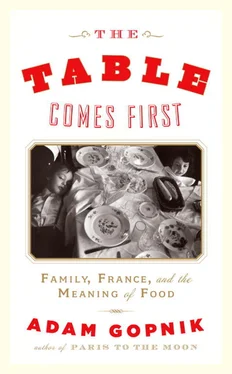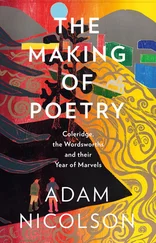More than any dessert I know—more than any soufflé, or molten cake—this rice pudding seems to delight the crowds, and what’s more, it appears to be sophisticated work. I suppose the blend of cardamom and coconut gives a misleading impression of premeditation. (Obviously, this would not be the case in India.)
My third rice pudding hails from Paris, and is a variant of the riz au lait that is such a standard dessert there. It isn’t quite like Greek-coffee-shop rice pudding, that New York staple, which is just a mix of rice and milk and sugar and vanilla, with, let it be said, cornstarch added. This one does something a little more ingenious than most recipes, which are really just marriages of milk and rice cooked slowly so that the rice soaks up the milk and the natural starch in the rice does the work of thickening. In this one, you make that kind of riz au lait —you know, Elizabeth, it’s so simple that it’s embarrassing to recipetize it; you just make sweet milky rice by simmering them together. The only trick is not to let it get too dry. Then you beat by hand a cup and a half of cream till it’s whipped but not quite in that stiff form, and you blend the sweet rice in with the whipped cream and then—this is important—pour it into a narrowish mold and let it refrigerate for quite a while, so that it stiffens up even more.
And once again, it suggests the magic of rice pudding: it overwhelms people, delights them, makes them smile and feel part of some peasant ritual, some rite of passage, even if the ceremony is only a midweek dinner. This is especially true if you serve either the Indian or the French rice pudding with little pots of extras: cherry jam, or dried apricots poached in white wine, something nice. It gives the whole thing a sense of unearned splendor, like listening to Keith play the opening riff of “Start Me Up” and then realizing that it’s just a bar chord and a simple minor seventh shape, up and down the neck of the guitar, simplicity itself, with the recklessness of true simplicity.
Why does rice pudding, in any of its forms, have this ritual resonance? The answer, I think, lies simply in the slowness of its achievement. Eggs are little miracles; one minute slime, the next a meal. Meats are primal. But a rice pudding develops in slow and gradual stages—not even stages, phases , a slow and gradual field, passing from inedible hard grains and unpalatable raw eggs and milk to some combined, involved, semisoupy, semicereal, sweet and starchy but both at once delight. Rice pudding is like life: it’s hard at first, gradually thickens, and ends well enough to make you wish you could have it again. No wonder we use it to mark life passages.
Yet I know, know deep down, that Keith would like these puddings. And your friend Whistler? Ah, Whistler would best like the baked one my mother does, which would remind him of his student days at West Point, of his youth in America, of his mother, too—who, we know, sits in her chair, patiently, while her brilliant boy paints her portrait, and thinks of what she will cook for him when he is done at last.
All best,
Adam
PART IV
Leaving the Table
THE SAVORY, serious part of the meal is over, and the talk is settling, and then—what happens? The sweet comes out, which some of the diners (the women, as it happens, most often) refuse to eat, and others relish. And there is a last drink, perhaps, and at home people begin to look at their watches (and the hosts longingly at the door), while in the restaurant the weary waiters begin to stack tables and pointedly if politely ask if you will be wanting anything more. At that moment, the bill to pay, the thanks to be offered (“It was absolutely wonderful!”—the degree of hysterical affirmation usually in direct reverse proportion to the degree of pleasure really taken), some sense of summary, of finish, even, perhaps, of a moral, is sought by those who came to the table. They want, it seems, something to take home….
I WORRY about French food in the new age of spices and world cooking, as one might worry about English damp in the age of global warming, or about Canadian civility under the stress of imported talk radio. Something that one just took for granted as a fixed feature of the world suddenly seems fragile and fugitive, even ailing—even, perhaps, on its way out.
Having written about the crisis in French food early on, I suppose I always secretly assumed that French cooking would snap right out of it, the way that North American ice hockey did under the stress of Russian competition. The internal resources of France for cooking were so deep-seated, so powerfully entrenched, so much a part of the logic and wit of French life, that the narrowness and stultified repetition that had overcome so much French cooking seemed sure to end simply with a renewed act of will. Since no one can be more willful than a French chef, it seemed to me merely a matter of time and timing before the inevitable opening-out would take place. A new Robuchon, a next generation Ducasse would seize, say, on North African spices as Carême had once seized on the herbs of Provence—and French cooking would be reborn.
Yet though I would still rather eat in Paris than anywhere else in the world—eating, once again, is a social act before it is a purely sensory one; it calls on our moral taste more than our measuring tongue, and my own moral taste still leads me back inexorably to the wit and intelligence of French civilization—I recognize that the rebirth has not happened, that the crisis I identified, only half-playfully, a decade or more ago is more entrenched now than it was then, and that fewer and fewer people who care about cooking now think of France as first among all others.
And still we go on searching for signs of life. New generations of bistros open, and though they seem more tense than tempting—the demands of French labor laws often lead to the smaller restaurants’ being staffed by an overstressed spouse and an overworked staff—I try them, and cheer. New geniuses are announced and sometimes even new guides are published, and of all of these the most “mediatized,” as the French say, and at the same time the most puzzling, is certainly the food guide published by the group that calls itself, with deliberate insolence, Le Fooding. (The insolence lies in using an English word.)
I suppose I would have an easier time deciding if Le Fooding is going to be able to accomplish all that it has set out to accomplish—which is nothing less than to do the whole of the job that needs to be done, to save the preeminence of French cuisine from going the way of the Roman Empire, the five-act tragedy, and the ocean liner—if I had an easier time defining what it is and what its principles at bottom truly are . That it is a phenomenon is beyond dispute, its success having reached the point where the French daily Figaro announced, last summer, that French food is now divided into two families, each with its own public and cultural identity: “On the one side, Michelin, with its century of cultural expertise; on the other the Fooding guide, born ten years ago in an attempt to break the codes and finally offer real change to a gastronomy that its authors judge to be outdated.”
Yet what, exactly, the new family stands for can be hard to say. At some moments, Le Fooding seems earnest, in the manner of the slow-food movement; at others, it is merely festive, a good-time gang; at still others, it appears determined to wrench the entire culture of good food in France from its historic place, on the nationalist right, to a new home, in the libertarian center. To spend a few months studying its founders and their ideas is to get pretty much the same feeling you get when, studying French history, you have to take up the story of Jansenism at Port-Royal in the seventeenth century: all you can really figure out is that it’s important, that it’s a heresy, and that it’s hard to follow.
Читать дальше












